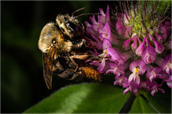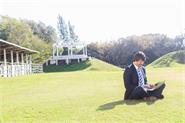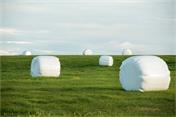1. Corn grows better when it follows red clover.
2. Red clover is as sensitive to soil acidity as alfalfa.
3. Available potassium and phosphorus are necessary for profitable yields of red clover.
4. Red clover is mainly used for soil improvement.
5. If poorly drained, soils must not be used for growing red clover.
Listening and Speaking Focus
Watch the video: Red Clover Seed Production https://www.youtube.com/watch?v=TnZhHeSuWZI
a) answer the questions below:
a. What are challenges about doing seed production on medium red clover?
b. What are the main pollinators of red clover?
c. How can we see that it is completely pollinated and the seed is starting to develop?
d. When do we know that it's ready to harvest?
e. What do people use red clover for?
b) make a summary of the video.
 |
c) discussion: What factors are of the greatest importance in increasing yields of red clover crops?
UNIT 21. GRASSLAND MANAGEMENT
| In this unit you will learn: | Grammar focus: - Functions of the Infinitive (revision). - Infinitive Constructions. Vocabulary focus Reading and comprehension focus: - Text A. Grassland management. - Text B. Sweetclover for soil improvement. - Text C. Listening and speaking focus |
Grammar Focus
Функции инфинитива

| Инфинитив – неличная форма глагола, которая обозначает действие, это неопределенная форма глагола (по-русски), которая выражает действие, но без уточнения лица или числа. Инфинитив отвечает на вопросы «что делать?», «что сделать?» – в словаре слова представлены в этой форме, например: to establish – устанавливать, to protect – защищать. Формальный признак инфинитива – частица to, которая в некоторых случаях опускается. |
Инфинитив в предложении может быть на месте любого члена предложения. Он может выполнять различные роли:
Подлежащее (subject):
To establish a pasture is very important. – Создание пастбища очень важно.
Дополнение (object):
Many farmers decide to renovate a pasture. – Многие фермеры решают обновить пастбище.
Часть составного сказуемого (predicate):
My decision is to renovate a pasture. – Я решил обновить пастбище.
Определение (attribute):
He was the best to solve this problem. – Он лучше всех решил эту проблему.
Обстоятельство (adverbial modifier):
It was made to bring biological changes in the soil. – Он был создан для того, чтобы вызвать биологические изменения в почве.
В качестве вводных слов или фраз (в разговорной речи):
To tell the truth, I don’t really like this pasture. – Честно говоря, я очень не люблю это пастбище.
Well, to cut a long story short, the work was awful. – Короче говоря, работа была ужасная.
Инфинитивные конструкции

|
|
В английском языке встречается оборот, состоящий из существительного в общем падеже и инфинитива. В таком обороте существительное обозначает лицо или предмет, совершающий действие, выраженное инфинитивом, или подвергающийся этому действию. Оборот называют самостоятельным инфинитивным оборотом (Absolute Infinitive Construction). Он стоит в конце предложения и отделен запятой, на русский язык переводится предложением с союзом "причем", в котором глагол выражает долженствование.
LESSON 21.1. GRASSLAND MANAGEMENT
1. Study carefully the Grammar Focus section of this unit .
2. Look through the following words. Write out those that make up 2 groups: a) verbs matching with the word soil, b) adjectives characterizing climatic conditions.
To improve, to remain, temperate, certain, to influence, to supply, necessary, wet, to maintain, to contain, moderate, most, warm, to prevent, moist, to cultivate, warmth, favourable, to affect, to prevail, cold, principal, to use, to hasten, to harrow, humid, fresh, to roll, moisture, to irrigate, different, deficient, to choose, dry, profitable, mild, to provide, to drain, variable, to respond, hot, rapid, to dig, to conserve, cool, to consume, to plow, proper, suitable, to fertilize.
3. Work with a dictionary and the Internet resources (e.g. https://education.nationalgeographic.org/resource/crop etc.) to make up a mind map of crops in English (what they are called in English and their Russian equivalents, properties, usage, etc.). It can be draw by hand or using digital means (e.g. https://www.mindmup.com/ or https://miro.com/mind-map/ and others.)
4. HIghlight the sentences that should be translated into Russian using the words “ который ”, “ чтобы ” or “ для того чтобы ” before an infinitive. Translate the sentences .
1. Planting of corn should always and be delayed until the ground is sufficiently dry to be worked and warm enough to favour germination.
2. Soils to be used for growing sweetclover may be less fertile and more alkaline than those for alfalfa.
3. To get maximum yields of high-quality hay one must choose the proper stage at which pasture plants are to be cut.
4. The two most important factors to be considered in selecting a crop variety to be grown are adaptation and the use which is to be made of it.
5. For obtaining profitable yields of a crop it is necessary to consider both environmental conditions and heredity.
6. Menures to be applied to corn land not only provide the necessary plant food, but also increase the water-holding capacity of the soil.
Vocabulary Focus

| Handwrite the words and word combinations related to text A and give their Russian equivalents. Check them in the agronomy and soil science dictionaries. |
| Grazing, to establish, to occupy, self-seeding, mutually, to protect, to benefit, coverage, furrow, composition. |
 |
5. Read and translate text А . Specify the sentences containing the following: (a) «Complex Subject» (para. 3, 4, 5, 7); (b) sentences in which the verb-form is before an infinitive is translated as « состоит в том , чтобы » (para. 1, 2); pattern « for + сущ. + инф.» ( para . 6); absolute participle construction ( para . 2). Read aloud the paragraph about the advantages of growing legumes and grasses together.
Text A
Grassland management
The chief object of good pasture maintenance is to provide green succulent feed for livestock during the entire grazing season. The dry matter of immature grasses is higher in protein and vitamins and is more digestible than the dry matter of mature grasses harvested for hay.
There exist several kinds of pastures, the two main groups being natural pastures and cultivated ones. Natural pastures are uncultivated lands occupied wholly or mainly by native types of forage plants. The main aim of establishing cultivated pastures is to grow those grasses and legumes which are able to provide more feed of better quality than the plants found in native pastures.
Two types of cultivated pastures appear to be most common: permanent and annual pastures. The former are made up of perennial grasses and legumes or of self-seeding annuals, or of both. They remain unplowed for long periods (five years or more). The latter are seeded each year to take the place of permanent pastures wholly or in part. One knows such postures usually to include crops like rye, oats, barley, Sudan grass, rye-grass, soybeans and rape.
Mixtures of grasses and legumes have been found to be more productive then seedings of grasses and legumes grown alone. If grown together, grasses and legumes are mutually beneficial. Grasses tend to protect legumes during winter, while legumes benefit grasses by providing them with nitrogen.
When choosing the seeding mixture to be grown, the farmer should consider the purpose for which it is to be used as well as the soil and climatic conditions prevailing in the locality. Thus, for some regions mixture of red clover and timothy has been found to be more popular than that of alfalfa and brome grass.
Since most of the plant species used for permanent pastures have small seeds, it's necessary to prepare a firm seedbed for the closer contact between the seed and soil particles to be established. It is the use of good seeds of small-seeded grasses and legumes that is important in providing good pasture coverage relatively free of weeds. The seed should be drilled rather than broadcasted on a new seedbed. Special drills for seeding grasses and legumes have attachments which open furrows, apply fertilizer, and cover the fertilizer with a soil.
The type and quantity of fertilizer applied has a marked effect on the composition of a pasture. Superphosphate is known to have a stimulating effect on the growth of all species, especially legumes, while nitrogenous fertilizers stimulate the growth of grasses.
Pasture maintenance or improvement may be brought about by reseeding, fertilization, and good grazing programme.
Notes to the text
1. to take the place of ... – заменить;
2. in part – частично;
3.
 |
to bring about – осуществлять.
Grammar and vocabulary activities
6. Translate the sentences. Mind the functions of the Infinitive.
1. Hot, dry winds increase water losses and in some areas are reported to reduce the yields of corn considerably.
2. It is advisable to sow cool-weather grasses in early fall, but early spring seeding is preferable on extremely heavy soils.
3. Soil moisture deficiency at the time of tuber formation of early potatoes has been found to seriously retard this process.
4. Liming materials are used to bring about chemical, physical and biological changes in the soil that are so beneficial to plant growth.
5. Nitrogen application in autumn does not seem to be required for winter wheat, provided sufficient application of this element was made in spring as a top dressing.
6. We know the physical properties of the soil, which is either too heavy or too light, to be improved by an increase of the humus content.
7. One of the aims of pasture maintenance is to keep a good balance between grasses and clovers.
8. There are many rotations to be followed in corn production, the best rotation being the one, that provides the abundance of organic matter.








